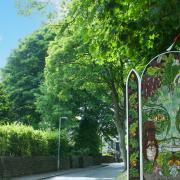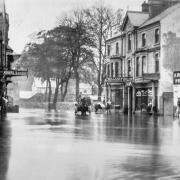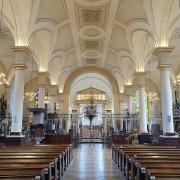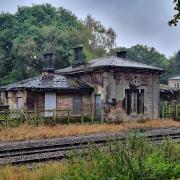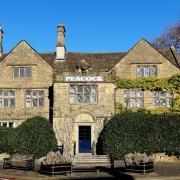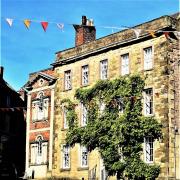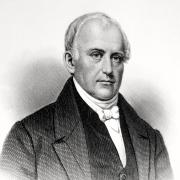Mike Smith heads to the south of the county to take in the incredible history of Repton’s fine St Wystan’s Church. He uncovers the story of a fascinating 1779 discovery that revealed a centuries-old secret
In 1779, a workman was digging a hole to house a grave in the floor of the chancel of St Wystan’s Church, in Repton, when he fell headlong into an underground room that had been completely hidden and forgotten about for several centuries.
The subterranean chamber, re-discovered by accident by the workman, turned out to be the oldest and most precious example of Anglo-Saxon architecture in the country.

You can gain access to this subterranean chamber by cautiously descending an uneven flight of steps through a curving low passageway until you emerge into an eerily still, silent space, no more than 16ft square by 10ft in height, which was described by Sir John Betjeman as ‘holy air encased in stone’.
As your eyes adjust to the dim light, you will be able to pick out, very gradually, the shape of the piers that support a low vaulted ceiling.
Topped by simple, trapezium-shaped capitals, the columns and pilasters are crudely decorated with carved spirals, some running clockwise, others anti-clockwise.

This unusual form of embellishment, unique in Anglo-Saxon architecture, is said to have influenced the styling of the shrine of Edward the Confessor in Westminster Abbey.
The crypt is thought to have been constructed in the first half of the 8th century, during the reign of King Æthelbald.
Designed originally as a baptistry, it was later converted into a mausoleum that became the final resting place of the Mercian kings, who ruled over a great swathe of England stretching from the Humber to the Thames, with Repton as its capital.
King Æthelbald and King Wiglaf were interred in the crypt, as was Wiglaf’s grandson, Wystan, who was the heir to the kingdom of Mercia.
Before his death in 840 AD, King Wiglaf is thought to have made the crypt slightly more elaborate in preparation for his own burial.
The ghostly presence of the Mercian kings in this ancient underground chamber is almost palpable.
Wystan rejected the kingship that was his right, opting instead for the religious life and monastic orders. In 849, he was murdered by his cousin and was hailed subsequently as a martyr.
His shrine became a place of pilgrimage, with passages being cut from the north-west and south-west corners of the crypt to manage the flow of pilgrims, who came to Repton in considerable numbers.
The current parish church, which was founded in the 10th century, when a chancel was built above the crypt, is dedicated to St Wystan.

A high-level doorway
The chancel, which has extensive traces of the original stonework, features an intriguing upper chamber set behind a wooden doorway built into the stone wall that rises from the top of the chancel arch to the roof of the church.
When you view this high-level doorway from the nave, you will be able to discern the ‘long and short work’ (comprising alternating vertical and horizontal slabs of stone) which forms a decorative frame on the right-hand side of the doorway.
A similar arrangement of stones can be spotted on the wall some distance from the left-hand side of the entrance, clearly indicating that the original doorway was much wider than it is now.
According to Dr Harold Taylor, who wrote a thoroughly researched history of St Wystan’s, this seemingly inaccessible chamber, hidden in the loft above the chancel, may have been designed as a secure place where relics could have been kept and from where they could have been taken out and displayed on feast days.
Another notable feature of the chancel is an excellent example of an Early English lancet window, which was blocked up for many years before it was opened again in 1885.
The tall window is best appreciated as a prominent architectural element when it is viewed from outside the north-eastern side of the church.
A needle-like spire
Many other changes and additions have taken place in the church over the centuries, with the result that the building has become almost cathedral-like in proportions.
By the end of the 15th century, the aisles had been widened, the nave had been lengthened and its height had been increased by the construction of a clerestory. Also, a two-storey south porch had been built.
However, the most significant addition to St Wystan’s had taken place in 1340, when a tower topped by a recessed spire was erected.
The elegant, needle-like spire, rising to a commanding height of 212 ft (65 m) and visible from a wide area of south Derbyshire, is a magnificent above-ground feature worthy of a church that boasts the best below-ground Saxon mausoleum in England.
Whilst you are there
Apart from having a magnificent church and a unique Saxon crypt, Repton is a very attractive village with lots of ancient buildings, including a well-known school founded in the 16th century. Nearby, two of Derbyshire’s best waterside attractions offer great family days out.

Repton School
The famous independent school was founded in 1557 on the site of a former Augustinian priory. Alumni include writers Roald Dahl and Christopher Isherwood, Archbishop of Canterbury Michael Ramsey, cricketer C B Fry and Harold Abrahams of ‘Chariots of Fire’ fame - and Jeremy Clarkson, who was asked to leave the school for ‘behaving unacceptably’.
The Boot Inn
The Boot Inn is a 17th century former coaching inn. It offers luxurious accommodation, serves award-winning classic and contemporary dishes, as well as real ales, including Boot Beer, brewed at the inn’s own micro-brewery.

The village of Repton
The former capital of the Kingdom of Mercia lines three main roads which intersect at an ancient market cross. All these roads feature some outstanding examples of Repton’s 49 listed buildings, including thatched and timbered structures dating from the 16th and 17th centuries.
Mercia Marina
Situated two miles from Repton, the marina is Derbyshire’s largest waterside marina attraction. A popular shopping and holiday destination, this watery wonderland contains 20 businesses, eleven shops, two restaurants and two coffee shops. It also provides boat trips and circular walks.

Foremark Reservoir
The reservoir, located 3.6 miles from Repton, is a 230-acre nature reserve managed by Severn Trent and the National Trust. It embraces woodland, grassland, heath and wetland, all of which you can explore on waymarked paths. A kiosk serves light refreshments and there is a children’s play area.








